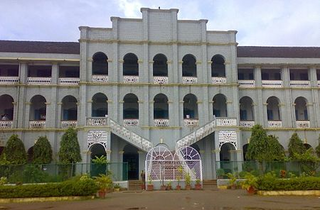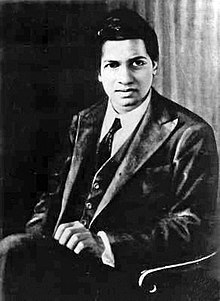
The University of Madras is a public state university in Chennai, Tamil Nadu, India. Established in 1857, it is one of the oldest and among the most prominent universities in India, incorporated by an act of the Legislative Council of India under the British government.

Loyola College is a private Catholic higher education institution run by the Society of Jesus in Chennai, Tamil Nadu, India. It was founded in 1925 by the French Jesuit priest, Francis Bertram, along with other European Jesuits. It is an autonomous Jesuit college affiliated with the University of Madras. Loyola commerce association celebrated its 75th year in 2019. Loyola College has more than 9000 students studying as of 2023.

Sri Venkateswara College of Engineering (SVCE) is an institute in Tamil Nadu, at Pennalur, Sriperumbudur near Chennai. SVCE was founded in 1985. The college was established by the Southern Petrochemical Industries Corporation (SPIC) group. SVCE is among the top engineering colleges of Anna University in Tamil Nadu and a Tier-I institution among self-financing colleges.
Alagappa College of Technology is an educational institution located in Chennai, Tamil Nadu, India that offers higher education in engineering, technology and allied sciences. The college was established in 1944 and was integrated with Anna University in 1978 from University of Madras as a constituent part of Anna University within its Guindy Campus.

The University of Calicut, also known as Calicut University, is a state-run public university headquartered at Tenhipalam in Malappuram district of the state of Kerala, India. Established in 1968, it is the first university to be set up in northern Kerala. The university is coordinated by the University Grants Commission.

Ranchi University is a public state university in Ranchi, Jharkhand, India. It was established in 1960 by an Act of the Bihar legislature. Ranchi University offers degrees in undergraduate, post-graduate, M.Phil. and doctorate programs.
The Sir Dorabji Tata Trust was established by Sir Dorab Tata, the elder son of Tata Group founder Jamsetji Tata. Founded in 1932, it is one of the oldest non-sectarian philanthropic organisations in India.

The Annamalai University is a public state university in Chidambaram, Tamil Nadu, India. The 1,500-acre (6.1 km2) sprawling campus offers courses of higher education in arts, science, engineering, management, humanities, agriculture, and physical education. The university also provides more than 500 courses through distance education. With over 32,480 students residing on campus, it is one of the largest teaching, and residential universities in Asia, and is among the most reputed and ranked universities in India including the rankings from NIRF, QS World University Rankings, Times University Rankings, CWTS Leiden Ranking, India Today Magazine, India Today MDRA, AISHE, ARIIA, SCImago Institutions Rankings.

Pondicherry University, also known as PU, is a central research university located in Kalapet, Pondicherry in Union Territory of Puducherry, India. It was established by an Act of Parliament in 1985 by the Department of Higher Education, Ministry of Education, Government of India. The Vice President of India is the Chancellor along with the Lieutenant Governor of Puducherry acting as the Chief Rector and the President of India is the Visitor of the university. The university is a collegiate university with its jurisdiction spread over the Union Territory of Puducherry located in Tamil Nadu, Kerala (Mahé) and Andhra Pradesh (Yanam), and Union Territory of Andaman and Nicobar Islands. The vast jurisdiction over three Union Territories namely gives the university a national character. The residents speak diverse languages such as English, Tamil, French, Telugu, Malayalam, Hindi, Bengali, Oriya, assamese, and Kannada.
Chennai is home to many educational and research institutions. IIT Madras, located in South Chennai is considered as the premier centre of engineering education in India. Anna University and the University of Madras are the oldest state owned universities which are ranked among the best universities in India. The College of Engineering, Guindy and Madras Institute of Technology, which are the constituent college of Anna University along with Alagappa College of Technology are the pioneer institutes of engineering education in India. Some of the oldest medical colleges India, the Madras Medical College (1835) and Stanley Medical College (1938) are located in the city. Notable, liberal arts colleges in the city include Loyola College, Madras Christian College, Presidency College, Stella Maris College, Women's Christian College and Ethiraj College for Women.
Cadambur Tiruvenkatachari Rajagopal was an Indian mathematician.

St. Aloysius is a private, coeducational, Jesuit deemed university, founded in 1880 as St. Aloysius College and located in Mangalore, Karnataka, India. With a 2022–23 enrollment of 5,436 undergraduate students and 1,587 postgraduate students and 69 research scholars, the institution specializes in academic programs in the humanities, commerce, science, technology, and management.

Vishwanathan Venkatachalam was an eminent Sanskrit scholar. He served as the vice-chancellor of Sampurnanand Sanskrit University, Varanasi, India for two terms. He was awarded the Padma Shri in 1989 by the Government of India for his valuable contribution to the field of Sanskrit research and education.

Jamal Mohamed College is a Government-aided and self-financed institution founded in 1951 by M. Jamal Mohamed Sahib and N.M. Khajamian Rowther. The college campus is located in Tiruchirappalli, India and is affiliated to Bharathidasan University. The Day session is for male students and the Evening session is for female students.

Raja Sir Muttaiya Annamalai Muthiah Chettiar was an Indian banker, politician, philanthropist, socialite and cultural activist who served as Mayor of Madras city (1933) and Minister of Excise and Education (1936–37) in the provincial government of Madras Presidency. He was holder of the hereditary title Kumar-rajah (1929–48) and later, Raja of Chettinad (1948–84).

Vels Institute of Science, Technology & Advanced Studies (VISTAS) is an institute of higher education located in Pallavaram, Chennai, Tamil Nadu, India. It was established in 1992 and granted Deemed University status in 2008 by University Grants Commission under section 3 of UGC Act 1956.

Munirathna Anandakrishnan was an Indian civil engineer, educationist, a chairman of the Indian Institute of Technology, Kanpur and a vice-chancellor of Anna University. He was also an Advisor to the Government of Tamil Nadu on Information Technology and e-Governance. A winner of the National Order of Scientific Merit (Brazil), he was honored by the Government of India, in 2002, with Padma Shri, the fourth highest Indian civilian award.

Rajpal Singh Sirohi is an Indian optics physicist, academic administrator, educator, and researcher in optical metrology. He is the former Director of IIT Delhi and Vice Chancellor of several universities. He is the Fellow of INAE, NASI, OSA, SPIE, OSI and ISoI. He has received numerous awards including Gabor Award of SPIE, Galileo Award of ICO. He is also the recipient of Padma Shri by Govt. of India. He is the author of about 430 papers and several books.
Mushi Santappa was an Indian polymer chemist, leather technologist and a vice chancellor of Sri Venkateswara University and the University of Madras. He was one of the founder directors of Avanti Leathers Limited and was known for his researches on the synthesis of graft copolymers, the properties of macromolecules, and osmotic techniques. He was an elected Fellow of the Indian Academy of Sciences, National Academy of Sciences, India, Royal Institute of Chemistry and New York Academy of Sciences and a founder fellow of the Academy of Sciences, Chennai. The Council of Scientific and Industrial Research, the apex agency of the Government of India for scientific research, awarded him the Shanti Swarup Bhatnagar Prize for Science and Technology, one of the highest Indian science awards, in 1967, for his contributions to chemical sciences.














